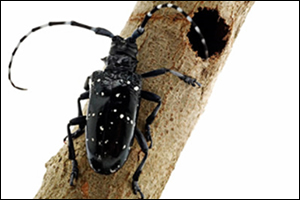LONG HORN BEETLE (ANOPLOPHORA BEETLE)
These are non-native wood-boring pests that can cause serious damage to a wide range of broad-leaved trees and shrubs. Bonsai growers are likely to become aware of the presence of these longhorn beetles either when they notice the adult beetle or find exit holes near the base of i trunks or exposed roots while exit holes of Asian longhorn can be much higher up a tree in the trunk or branches.
Larvae of this beetle tunnel in the roots, trunk and branches of living trees –in the lower trunk and main roots. Eggs are normally deposited a few inches above ground level in T-shaped slits prepared by the female with her mandibles.
At first, the larvae tunnels in the sapwood, but later penetrates the heartwood – often parallel to the growth axis – making tunnels up and down until most of the frass (excrement of the larvae) is ejected through the bark. The pupal cell is constructed in the heartwood, with a curved tunnel reaching to the bark. Adults emerge mostly in late April, May and June, and are active day-flyers.
The male beetle has a head, with antennae, that is one and a half times the length of the body – up to 2 inches in length. The female’s head is slightly longer than the body.

